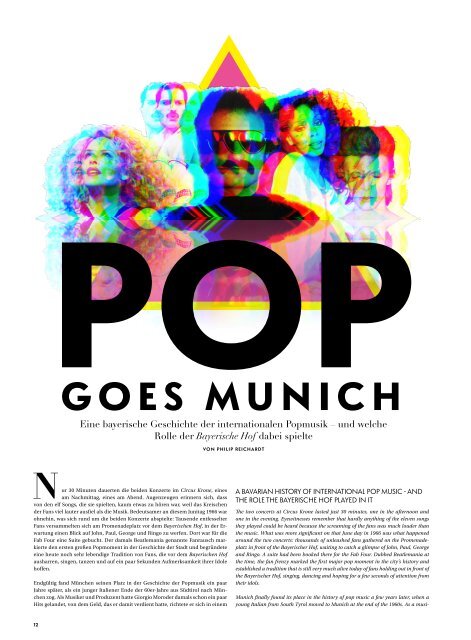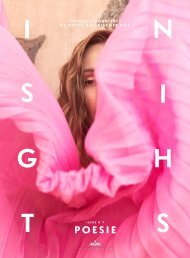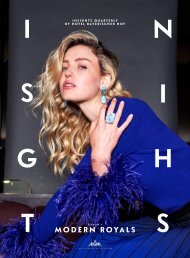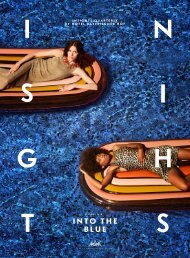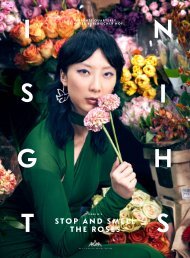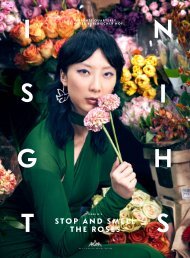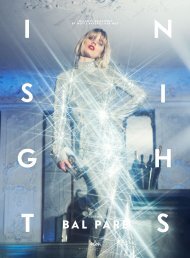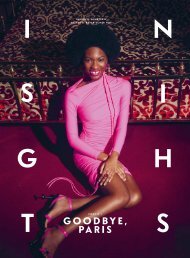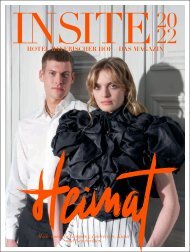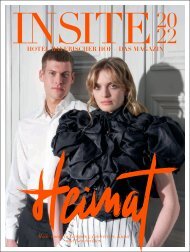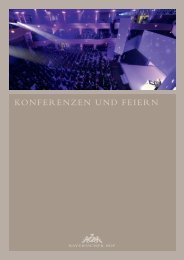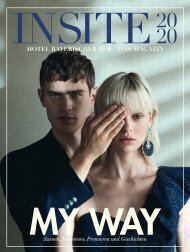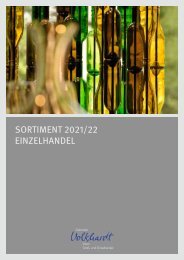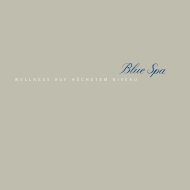Sie wollen auch ein ePaper? Erhöhen Sie die Reichweite Ihrer Titel.
YUMPU macht aus Druck-PDFs automatisch weboptimierte ePaper, die Google liebt.
HAUSPOST<br />
Keller in Bogenhausen ein Tonstudio ein. Ursprünglich wollte er es ganz alleine<br />
nutzen, um dort in aller Ruhe die Möglichkeiten des Synthesizers zu erforschen,<br />
einem Computer, mit dem sich Musik machen ließ. Doch kaum hatte Moroder das<br />
Musicland Studio eröffnet, bekam er Angebote aus England, das Studio zu vermieten.<br />
Es gab gutes Geld, er sagte zu und ihm blieb Zeit genug, mit dem Synthesizer<br />
eine neue, elektronische Klangwelt zu erschaffen, welche die Musikwelt Mitte der<br />
Siebzigerjahre revolutionierte, den „Sound of Munich“.<br />
“'CRAZY LITTLE THING<br />
CALLED LOVE'<br />
TOOK ME FIVE OR TEN<br />
MINUTES“<br />
POP<br />
GOES MUNICH<br />
Eine bayerische Geschichte der internationalen Popmusik – und welche<br />
Rolle der Bayerische Hof dabei spielte<br />
Nur 30 Minuten dauerten die beiden Konzerte im Circus Krone, eines<br />
am Nachmittag, eines am Abend. Augenzeugen erinnern sich, dass<br />
von den elf Songs, die sie spielten, kaum etwas zu hören war, weil das Kreischen<br />
der Fans viel lauter ausfiel als die Musik. Bedeutsamer an diesem Junitag 1966 war<br />
ohnehin, was sich rund um die beiden Konzerte abspielte: Tausende entfesselter<br />
Fans versammelten sich am Promenadeplatz vor dem Bayerischen Hof, in der Erwartung<br />
einen Blick auf John, Paul, George und Ringo zu werfen. Dort war für die<br />
Fab Four eine Suite gebucht. Der damals Beatlemania genannte Fanrausch markierte<br />
den ersten großen Popmoment in der Geschichte der Stadt und begründete<br />
eine heute noch sehr lebendige Tradition von Fans, die vor dem Bayerischen Hof<br />
ausharren, singen, tanzen und auf ein paar Sekunden Aufmerksamkeit ihrer Idole<br />
hoffen.<br />
Endgültig fand München seinen Platz in der Geschichte der Popmusik ein paar<br />
Jahre später, als ein junger Italiener Ende der 60er-Jahre aus Südtirol nach München<br />
zog. Als Musiker und Produzent hatte Giorgio Moroder damals schon ein paar<br />
Hits gelandet, von dem Geld, das er damit verdient hatte, richtete er sich in einem<br />
VON PHILIP REICHARDT<br />
A BAVARIAN HISTORY OF INTERNATIONAL POP MUSIC - AND<br />
THE ROLE THE BAYERISCHE HOF PLAYED IN IT<br />
The two concerts at Circus Krone lasted just 30 minutes, one in the afternoon and<br />
one in the evening. Eyewitnesses remember that hardly anything of the eleven songs<br />
they played could be heard because the screaming of the fans was much louder than<br />
the music. What was more significant on that June day in 1966 was what happened<br />
around the two concerts: thousands of unleashed fans gathered on the Promenadeplatz<br />
in front of the Bayerischer Hof, waiting to catch a glimpse of John, Paul, George<br />
and Ringo. A suite had been booked there for the Fab Four. Dubbed Beatlemania at<br />
the time, the fan frenzy marked the first major pop moment in the city’s history and<br />
established a tradition that is still very much alive today of fans holding out in front of<br />
the Bayerischer Hof, singing, dancing and hoping for a few seconds of attention from<br />
their idols.<br />
Munich finally found its place in the history of pop music a few years later, when a<br />
young Italian from South Tyrol moved to Munich at the end of the 1960s. As a musi-<br />
FOTOS ISOLDE OHLBAUM/LAIF<br />
Dass Moroder sich für München entschied und nicht für Mailand, London oder<br />
Paris, war kein Zufall. Denn mit den amerikanischen GIs kam nach dem Krieg<br />
auch der Jazz und später der Soul nach München. AFN, der Radiosender der amerikanischen<br />
Streitkräfte, sendete von München Musik für seine Angehörigen, und<br />
machte gleichzeitig zwei Generationen von Münchnern mit der Musik von Miles<br />
Davis, Aretha Franklin und James Brown vertraut. Viel früher als anderswo in<br />
Deutschland gab es Motown-Platten zu kaufen, und wenn Musiker aus den USA in<br />
Deutschland gastierten, traten sie zuerst in München auf, etwa im Big Apple in der<br />
Leopoldstraße. Jimi Hendrix spielte dort sein erstes Konzert in Europa. Als München<br />
den Zuschlag für die Olympischen Spiele 1972 erhielt, flirrte München nicht<br />
nur musikalisch, die ganze Stadt war nun im Aufbruch und bereit für die Zukunft.<br />
Musikalisch begann sie 1976, als Moroder im Musicland Studio „Love to Love you“<br />
aufnahm, einen Song, der mit den damaligen Hörgewohnheiten und Songschemata<br />
komplett brach. 17 Minuten lang, zu hören war ein treibender Beat und das<br />
Stöhnen einer jungen Gospelsängerin aus den USA. Donna Summer nannte sie<br />
sich, für eine Rolle im Musical „Hair“ war sie nach München gezogen, Moroder<br />
gefiel ihre warme Soulstimme. „Love to Love you“ eroberte zunächst die Discotheken<br />
in New York, dann die amerikanischen Charts, schließlich die restlichen<br />
Tanzflächen der westlichen Welt.<br />
Noch erfolgreicher wurde ein Jahr später „I feel Love“. Moroder entlockte dem<br />
Synthesizer Rhythmen, „die pumpten wie ein aufgeregtes Herz“, Donna Summer<br />
machte eine Weltkarriere als Queen of Disco. Moroders energetische Beats und<br />
clevere Arrangements wurden zum Vorbild für unzählige Produktionen und machten<br />
München in Sachen Disco zu New Yorks kleiner Schwester. „I feel Love“ gilt bis<br />
heute als Blaupause der elektronischen Tanzmusik.<br />
Die Möglichkeiten des Musicland Studios lockten fortan die ganz Großen an die Isar.<br />
Marc Bolan und die Rolling Stones hatten es schon vor Moroders Welterfolg entdeckt,<br />
sie spielten dort „It‘s Only Rock’n’Roll“ und „Black and Blue“ ein, Iggy Pop,<br />
Deep Purple, Elton John, Led Zeppelin und viele andere folgten. In dieser Zeit begann<br />
auch die Liebe vieler großer Stars zum Bayerischen Hof. Münchens Rolle im<br />
Popbusiness wurde verewigt im Refrain: „New York, London, Paris, Munich, everybody<br />
talks about Pop Music“, einem großen Hit von 1979, „Popmuzik“ hieß er.<br />
Dass Pop-und Rockstars München schätzten, lag auch am in der Stadt weit verbreiteten<br />
Hang zum Hedonismus und den Möglichkeiten des Münchner Nachtlebens.<br />
Studenten, Künstler, Geldadel und Filmemacher verband die Lust am Feiern<br />
gleichermaßen, und so kamen sie zusammen an Orten, die längst Legende sind.<br />
Im Blow Up, der ersten sogenannten Großraumdisco, dem Yellow Submarine,<br />
dessen Attraktion ein riesiges Aquarium war, in dem Haie schwammen, später im<br />
Eastside, im Why Not, der Rock Disco Sugar Shack und im Parkcafe. Und natürlich<br />
im P1, im Seitenflügel des Haus der Kunst, bis heute der Klassiker im Münchner<br />
Nachtleben.<br />
GOLDENE JAHRE<br />
Nahm 1976 in den<br />
Musicland Studios<br />
sein Album „Golden<br />
Years“ auf und<br />
übernachtete im<br />
Bayerischen Hof:<br />
Pop-Legende<br />
David Bowie<br />
FREDDIE MERCURY<br />
BADEMUSIK<br />
Ob Mercury den Song<br />
nun tatsächlich in der<br />
Badewanne seiner Suite<br />
im Bayerischen Hof<br />
geschrieben hat oder<br />
doch in einem anderen<br />
Hotel, bleibt ein Geheimnis<br />
cian and producer, Giorgio Moroder had already landed a few hits at the time, and he<br />
used the money he had earned to set up a recording studio in a basement in Bogenhausen.<br />
Originally, he wanted to use it all by himself to explore the possibilities of the<br />
synthesiser, a computer that could be used to make music. But as soon as Moroder had<br />
opened the Musicland Studio, he received offers from England to rent out the studio.<br />
There was good money, he accepted and he had enough time to use the synthesiser<br />
to create a new, electronic world of sound that revolutionised the music world in the<br />
mid-seventies, the “Sound of Munich”.<br />
It was no coincidence that Moroder chose Munich over Milan, London or Paris. After<br />
the war, jazz and later soul came to Munich with the American GIs. AFN, the radio<br />
station of the American armed forces, broadcast music from Munich for its members,<br />
and at the same time familiarised two generations of Munich residents with the music<br />
of Miles Davis, Aretha Franklin and James Brown. Motown records were on sale much<br />
earlier than anywhere else in Germany, and when musicians from the USA made<br />
guest appearances in Germany, they performed in Munich first, for example at the<br />
“Big Apple” in Leopoldstarße. Jimi Hendrix played his first concert in Europe there.<br />
When Munich won the bid to host the 1972 Olympic Games, it was not only shimmering<br />
musically, the whole city was now on the move and ready for the future.<br />
Musically, it began in 1976, when Moroder recorded “Love to Love you” in the Musicland<br />
Studio, a song that completely broke with the listening habits and song patterns<br />
of the time. 17 minutes long, it featured a driving beat and the moaning of a young<br />
gospel singer from the USA. She called herself Donna Summer, she had moved to Munich<br />
for a role in the musical “Hair”, Moroder liked her warm soul voice. “Love to Love<br />
You” first conquered the discos in New York, then the American charts and finally the<br />
rest of the dance floors of the western world. “I feel Love” was even more successful a<br />
year later. Moroder elicited rhythms from the synthesiser “that pumped like an excited<br />
heart”, Donna Summer made a global career as the Queen of Disco. Moroder’s energetic<br />
beats and clever arrangements became the model for countless productions and<br />
turned Munich into New York’s little sister when it came to disco. “I feel Love” is still<br />
considered the blueprint of electronic dance music today.<br />
From then on, the possibilities of the Musicland Studio attracted the really big names<br />
to the Isar. Marc Bolan and the Rolling Stones had already discovered it before Moroder’s<br />
worldwide success, they recorded “It’s Only Rock Roll” and “Black and Blue” there,<br />
Iggy Pop, Deep Purple, Elton John, Led Zeppelin and many others followed. It was also<br />
during this time that many big stars fell in love with the Bayerischer Hof. Munich’s role<br />
in the pop business was immortalised in the chorus: “New York, London, Paris, Munich,<br />
everybody talks about pop music”, a big hit from 1979 called “Popmuzik”.<br />
The fact that pop and rock stars favoured Munich was also due to the city’s widespread<br />
penchant for hedonism and the opportunities offered by Munich’s nightlife. Students,<br />
artists, moneyed aristocrats and film-makers alike were united by their desire to party,<br />
and so they came together in places that have long since become legendary. At the<br />
Blow Up, the first so-called open-plan disco, the Yellow Submarine, whose attraction<br />
was a huge aquarium in which sharks swam, later at the Eastside, the Why Not, the<br />
rock disco Sugar Shack and the Parkcafe. And of course at P1, in the side wing of the<br />
Haus der Kunst, still a classic in Munich’s nightlife today.<br />
Freddie Mercury also came to Munich in 1979. Originally only to record the album<br />
“The Game” with Queen at Musicland Studios. But even more than Moroder’s exquisite<br />
recording studio, Mercury appreciated the opportunities the city offered him at the<br />
time. At the time, Munich was also considered one of the strongholds of queer life in<br />
Europe. He wandered through the bars of the Glockenbach district with actress Barbara<br />
Valentin, fell in love and stayed. For five years. During this time, he recorded four<br />
albums with his band in Munich, as well as his only solo album, “Mr Bad Guy”.<br />
12<br />
13


